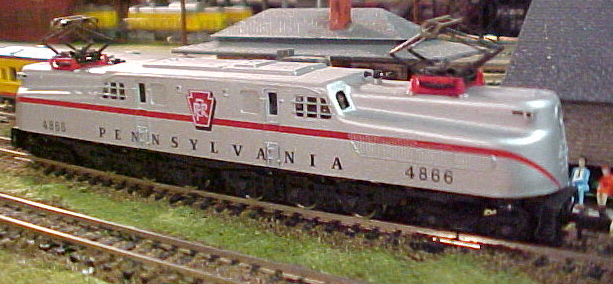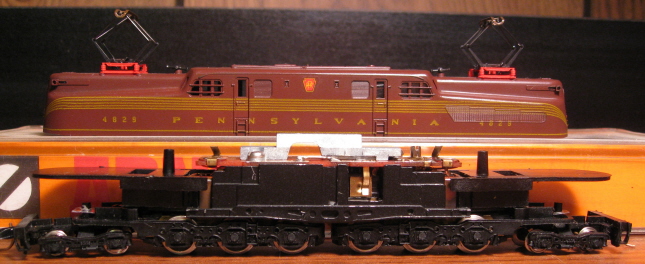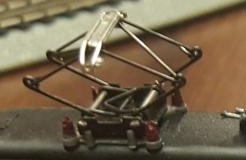

Introduced: 1971 (discontinued circa 2006)
This is probably Arnold's most impressive N scale locomotive (at least as far as their North American prototypes are concerned). It's a cool prototype, it looks great, and it performs quite well. These were originally imported into the US by Revell (a relationship that lasted until around 1972). After that Arnold used various importers (Walthers, most noteably). Sometime in the 1990s Arnold was acquired by Rivarossi and these models lived on for a time. They were ultimately discontinued with the bankruptcy and subsequent liquidation of Rivarossi in 2006. They are found most commonly in the traditional Arnold "plastic box with orange inserts".
I'm told that all of Arnold's GG-1 paint schemes are relatively accurate vis'a'vis the various prototypes, although the actual colors they chose are somewhat "off".

The mechanism consists of a central metal chassis that houses the 3-pole motor and the gears. A PC board mounted to the top of the chassis takes care of moving current around (IE, no wires). A rotating contact on top of the PC board allows one to switch between drawing current from the rails or drawing current from the (working) pantographs. Directional lighting is provided by bulbs mounted on either end of the chassis. Each truck assembly consists of a three-axle truck linked to a two-axle truck. The outer two-axle trucks are simply idlers (no gears, no pickup). On the three-axle truck, the innermost wheels are idlers (no pickup, no gearing). On the geared axles, three out of the four wheels provide pickup (with the fourth being traction-tire equipped). The couplers are truck-mounted Rapidos.
Performance is quite impressive. Mine has no pickup problems whatsoever (even through turnouts), and overall throttle response is quite smooth. Slow speed creep is decent (if unspectacular), although the top-end is pretty much meteoric. Arnold's GG-1 isn't quite as quiet as more modern models (particularly at slower speeds, where the motor tends to growl and hum). However, it certainly makes far less noise than some of Arnold's other 1970s-era models. Kind of surprising, given all those metal gears in the trucks. Pulling power is very good (not surprising given the heft of the chassis along with the traction tires).
On the down side, this model does not perform particularly well on narrow (9.75") radius curves. The forward and trailing 2-axle trucks are quite light and have a tendancy to hop the rails when faced with sharp curves. And derailing aside, this model just plain looks weird navigating said narrow curves. Also, this model appears to be just a bit top-heavy, and when faced with any sort of unevenness in the track, it does tend to wobble a bit in response (an affect made to appear all the worse by those tall pantographs). The wheel flanges are very deep, so forget about running this on anything like Code-55 track. Early runs of this model came with paper stickers for some of the graphics (rather than being painted/printed). Yikes.
Overall, this is a very cool looking model that performs quite well (especially for its era). Definitely operations-worthy.
AFAIK, this model remained essentially the same over its production history. That said, the pantographs did change at some point (I'm not sure which came first) -


To remove the shell, simply unscrew the big ugly screw up on top.
Grade: B
Reviewed: 12/71 Model Railroader ("The ready-to-run Rapido model closely follows the proportions and scale dimensions of the prototype. A few liberties have been taken to accommodate the mechanism... The one piece cast plastic superstructure comes painted Pennsylvania black with white lettering. The working metal pantographs are attached to the body with machine screws. The mechanism is quite ingenious. A small double-ended shaft motor occupies the central cab area. The main frame is a zinc alloy casting with a PC board mounted on its top side. This carries all electrical connections. The headlights and number boards are illuminated with a rectified directional control. A small switch located atop the circuit board converts the locomotive from two-rail operation to one-rail and overhead operation. (The cab must be removed to change over.) The trucks are articulated in a manner similar to the prototype. All side frames and gearbox enclosures are well-detailed plastic castings. The drive wheels have plastic centers and nickel-silver rims. The pilot truck wheels are plastic. Four wheels of each truck are powered and two of the eight powered wheels have plastic friction treads. The pilot wheels are are close to scale dimension but the driving wheels are scale 9" smaller than indicated on prototype diagram sheets. The wheels have a flange depth of .038". The check gauge is .323" and the back-to-back dimension is .310". Brass worms are attached to both ends of the motor meshing with broad-cut gears that swivel with the truck mechanism. Spur gears transfer the motion to the axles... Rapido-type automatic couplers are used on both ends of the model. Some of the pilot has been omitted to accommodate the bulk of the coupler and draft gear... Our sample ran smoothly... Our sample pulled 15 full length passenger cars of various weights, and manufacturer... A fine running model. The only noticeable deviation from prototype design is the small driving wheels and the body setting high on its frames. This is probably one of the most advanced and finest locomotives yet designed for the N scale modeler. Price: $45")
Reviewed again: 10/87 Model Railroader ("Arnold's model of the GG1 is nicely proportioned, and it closely matches prototype dimensions. It is a scale 76'-8" long (over the ends of the body), 10'6" wide and about 15'-0" high over the closed pantograph... Our sample GG1 has a crisply molded plastic body with added details like the air horns, windows, headlight lenses, and working metal pantographs. (The pantographs may be used for electrical pickup if desired.) The GG1 is neatly painted in a dark green that closely approximates the PRR Brunswick Green used on freight units. A matching GG1 in Tuscan Red is also available. Both versions have the five-stripe graphics printed on. The body is a tight fit over the weights and frame portion of the running gear, and a single screw (down through the roof) holds it in place. Like the prototype, the model chassis is divided into two sections. Each chassis half includes three drivers and a four-wheel lead truck. A large cast block of metal serves as a combination main frame, motor mount, and weight. The motor fits into a molded opening in the center of the frame with universals, drive shafts, and worm gears conncted to each end. The power trucks are made of rigid dark gray castings that do not equalize. The worm on the drive shaft engages a worm gear on the top of each truck to carry the motion into the truck. Inside the trucks the worm gears turn a pair of geared axles (the two axles closest to the center of the locomotive). One axle on each truck has a traction tire to improve pulling power. A small phosphor bronze pickup rides on the back of the powered wheelsets for electrical pickup. Our sample GG1 was a bit ragged and noisy in its running characteristics to begin with... I do not expect it will ever measure up to the performance level of the newer N scale locomotive designs as the GG1 drive simply is an older design with looser tolerances. As it comes, the unit will pull about 38 free-rolling freight cars on straight and level track... Overall, this miniature GG1 has captured the general appearance and proportions of its prototype. $99.98")